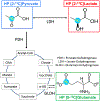First hyperpolarized [2-13C]pyruvate MR studies of human brain metabolism
- PMID: 31648132
- PMCID: PMC6880930
- DOI: 10.1016/j.jmr.2019.106617
First hyperpolarized [2-13C]pyruvate MR studies of human brain metabolism
Abstract
We developed methods for the preparation of hyperpolarized (HP) sterile [2-13C]pyruvate to test its feasibility in first-ever human NMR studies following FDA-IND & IRB approval. Spectral results using this MR stable-isotope imaging approach demonstrated the feasibility of investigating human cerebral energy metabolism by measuring the dynamic conversion of HP [2-13C]pyruvate to [2-13C]lactate and [5-13C]glutamate in the brain of four healthy volunteers. Metabolite kinetics, signal-to-noise (SNR) and area-under-curve (AUC) ratios, and calculated [2-13C]pyruvate to [2-13C]lactate conversion rates (kPL) were measured and showed similar but not identical inter-subject values. The kPL measurements were equivalent with prior human HP [1-13C]pyruvate measurements.
Keywords: Brain metabolism; Hyperpolarized C13; Metabolic imaging.
Copyright © 2019 Elsevier Inc. All rights reserved.
Conflict of interest statement
Declaration of Competing Interest
The authors declare that they have no known competing financial interests or personal relationships that could have appeared to influence the work reported in this paper.
Figures







References
-
- Park Ilwoo, Larson Peder E.Z., Gordon Jeremy W., Carvajal Lucas, Chen Hsin-Yu, Bok Robert, Van Criekinge Mark, Ferrone Marcus, Slater James B., Xu Duan, Kurhanewicz John, Vigneron Daniel B., Chang Susan, Nelson Sarah J., Development of methods and feasibility of using hyperpolarized carbon-13 imaging data for evaluating brain metabolism in patient studies: hyperpolarized Carbon-13 metabolic imaging of patients with brain tumors, Magn. Reson. Med 80 (3) (2018) 864–873, 10.1002/mrm.v80.310.1002/mrm.27077. - DOI - PMC - PubMed
Publication types
MeSH terms
Substances
Grants and funding
LinkOut - more resources
Full Text Sources
Research Materials
Miscellaneous

